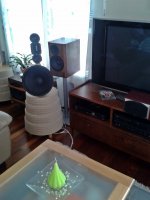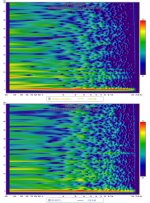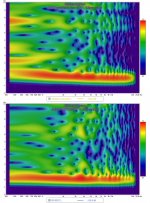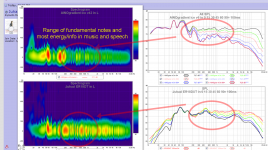I agree with #13 in Markus's post, in my experience, it depends on the room.Speaker Dave, are you suggesting that two speakers with a flat direct response, but one with high directivity and the other with low directivity, may not actually sound very different in practice?
How do your cardioids sound compared to your other speakers in the same room?
I have messed around a dipole speaker project with numerous measurements. For a sanity check I measured also my 2-way BR speaker, a variation of MarkK's ER18DXT. I can verify that in my conventional living room with RT around 0.3 - 0.5, The dipole spekers produce significantly more accurate and pleasant sound. Reflections, seen as spectral decay up to 300ms are markedly less with the dipoles (one speaker's measurements shown here.
Juhazi;
Your spectrogram would show actual room reflections if in controls group time range is set around 50ms, and window to <3ms. In SPL, if offset is set to bring peak range to 0db, then range in spectrogram plot will give good indication of reflections general intensity.
Here is listening position with clone of Linkwitz Pluto:
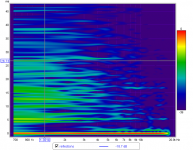
With little effort, walls, ceiling, floor, and combinations of reflections can be identified by horizontal banding.
RT60 is crude and crappy statistic with little relevance to listening rooms.
Here are same measurement in diferent scale. Window is 3ms in both, scale 10ms and 50ms.
How to interprete this? Aino has less early reflections and more late reflections?
The auditory remarks are that AINOs have remarkably better imaging, instuments and players stay on their seats, handclaps of a live recording are very precise etc. This is exacly what I was hoping and expecting for. The difference is not very huge, because ER18DXTs are quite good at imaging too. I don't have omnidirectional speakers at home. My Sonab OA-13s are at the summer cabin!
A photo of the setup (not exactly but close..) The speakers were next to each other. Notice the window and plasma tv on the "front wall" and the glass table - a really non-audiophile setup!
How to interprete this? Aino has less early reflections and more late reflections?
The auditory remarks are that AINOs have remarkably better imaging, instuments and players stay on their seats, handclaps of a live recording are very precise etc. This is exacly what I was hoping and expecting for. The difference is not very huge, because ER18DXTs are quite good at imaging too. I don't have omnidirectional speakers at home. My Sonab OA-13s are at the summer cabin!
A photo of the setup (not exactly but close..) The speakers were next to each other. Notice the window and plasma tv on the "front wall" and the glass table - a really non-audiophile setup!
Attachments
Last edited:
"Looks like the AINO one has more reflections period"
- yep. But they are rather late concidering perception. In my previous psot we can see that Ainos generate less very late reflections/decay (100ms or more) The dipole function of AINOs is ~200-3200Hz and it means that it radiates backwards as much as forward, but different phase. This means minimal radiation energy sideways. Generally dipoles should not be close to the front wall. My measurements show why!
- yep. But they are rather late concidering perception. In my previous psot we can see that Ainos generate less very late reflections/decay (100ms or more) The dipole function of AINOs is ~200-3200Hz and it means that it radiates backwards as much as forward, but different phase. This means minimal radiation energy sideways. Generally dipoles should not be close to the front wall. My measurements show why!
Last edited:
Maybe dummy head binaural impulse responses are the next step in understanding small room acoustics.
I've been thinking the same thing lately.
Hi,
spl levels were not matched. The amps are not same. I don't think it makes a difference to the decay or spl readability. I have made several measurement of both (and many others) and results are consistent and similar to these shown here. I use now a calibrated UMIK-1, ObjectiveDAC and latest B-version of REW.
I am not a scientist and my measurement are not "industry standard" I am just a hobbyist with a large family, a daytime job and many other hobbies and interests.
I just joined the AES and I am going to attend to this! AES 51st Conference on Loudspeakers and Headphones
- S Linkwitz is one of the invited speakers http://www.aes.org/conferences/51/invited_speakers.cfm#Linkwitz
- these topics look interesting:
Loudspeaker Modeling
spl levels were not matched. The amps are not same. I don't think it makes a difference to the decay or spl readability. I have made several measurement of both (and many others) and results are consistent and similar to these shown here. I use now a calibrated UMIK-1, ObjectiveDAC and latest B-version of REW.
I am not a scientist and my measurement are not "industry standard" I am just a hobbyist with a large family, a daytime job and many other hobbies and interests.
I just joined the AES and I am going to attend to this! AES 51st Conference on Loudspeakers and Headphones
- S Linkwitz is one of the invited speakers http://www.aes.org/conferences/51/invited_speakers.cfm#Linkwitz
- these topics look interesting:
Loudspeaker Modeling
- Jaakko Nisula, Juha Holm, Aki Mäkivirta: Calculating sound radiation from loudspeaker enclosures using the finite element method
- Ulrik Skov, René Christensen: Overview of Electromagnetic, Structural, Vibroacoustic & Viscothermal Linear & Non-Linear 2D & 3D FEA simulations on
- Juha Holm, Aki Mäkivirta: Quantifying diffraction in time domain with finite element method
- Pasi Marttila, Mads Jakob Herring Jensen: A hybrid electroacoustic lumped and finite element model for modeling loudspeaker drivers
Last edited:
Hi,
- these topics look interesting:
Loudspeaker Modeling
- Jaakko Nisula, Juha Holm, Aki Mäkivirta: Calculating sound radiation from loudspeaker enclosures using the finite element method
- Pasi Marttila, Mads Jakob Herring Jensen: A hybrid electroacoustic lumped and finite element model for modeling loudspeaker drivers
Hi Juhazi,
In this case, you may be interested in http://www.bodziosoftware.com.au/Cone_Break_Up.zip
Best Regards,
Bohdan
Lipshitz's conclusions:
"1) Flat power produced at the expense of non-flat axial response
produces a colored overbright and definitely 'wrong' sound in the
case of loudspeaker #1. The effect is worse in the smaller
listening room....
Thanks for quoting Lipshitz's full conclusions. I had been paraphrasing a bit.
Between the Bech studies and L&R tests we are dealing with two ends of a similar issue, but there are important distinctions to be made. In a speaker we can consider polar pattern and its exact shape, or simply the aggregate Q or directivity index (d.i. = 10 log Q). A singular Q can be derived from a particular polar curve, but many polar curves can have the same Q.
Knowing polar curves or response at all angles you can do what Bech does: calculate response and level of any particular room reflection. By recreating an artificial room he was able to manipulate any reflection and find that most reflections were well below the level needed for detection.
L&R come at it from the other end and could conclude nothing about particular reflections but end up defining some useful rules about frequency response and power response. I like to compare what Toole shows about power response with L&R as they compliment each other. Toole's group tests show that flat frequency response is more important than any power response curve and that a "good" power response doesn't offset a bad frequency response. Toole's preferred speakers have a generally falling power response of no particular shape. Well ranked speakers typically had power response holes at the crossover points. Similarly, L&R comment that power response peaks are audible but holes, not nearly as much. They also suggest monotonically falling power response (Rising d.i.) as being best but assume there is an acceptable range. Less directional speakers (increased power response) will sound bright, L&R suggest, even if their axial response is flat.
Could power response and frequency response be exchanged, that is, could you offset a somewhat brighter power response curve with a duller on axis curve? I think you can, at least in part. I know the designer of the Mirage Omnisats, speakers that were horizontally omnidirectional. He found that they could sound well balanced if the axial response was given a few dB of intentional droop. Otherwise they sounded too bright?
This is still not the best course to take as the room becomes a required element of perceived response. "Omnidirectional" sounds no different than "ultra beamy" in an anechoic chamber. If wider dispersion is going to offset duller on axis response, then the room needs to fall within some limits. Sticking with an axially flat but climbing d.i. approach is more likely to transfer from room to room.
In the end, how do we reconcile L&R's "power response is important" with Bech's "most reflections are inaudible"? Remember that Bech's study takes each reflection in issolation and turns it up and down to find the JND level or Threshold of Detection. As L&R manipulate the power response of a speaker, they are essentially turning all the reflections up and down. I can believe that those 2 approaches will give different results.
If we accept both studies we must conclude that general directivity is important but specific polar curves are less critical.
David
Whenever I look at measurements of real rooms, most reflections appear to be above threshold.
Depending on the speaker's radiation pattern there are second order reflections that can be pretty loud. They perceptually combine with other reflections from similar angles. This has been shown by Cremer/Müller.
Thresholds are also highly signal dependend with clicks having the lowest threshold. See Olive/Toole.
There's probably also a high variability between individuals. See Litovsky.
Of course there are other requirements in sound reproduction that have to be met first (direct frequency response, matched speaker response, shape of wavefront), but after that it's the room's reverberant field that highly affects perception of timbre, spaciousness, loudness, localization and detail.
Depending on the speaker's radiation pattern there are second order reflections that can be pretty loud. They perceptually combine with other reflections from similar angles. This has been shown by Cremer/Müller.
Thresholds are also highly signal dependend with clicks having the lowest threshold. See Olive/Toole.
There's probably also a high variability between individuals. See Litovsky.
Of course there are other requirements in sound reproduction that have to be met first (direct frequency response, matched speaker response, shape of wavefront), but after that it's the room's reverberant field that highly affects perception of timbre, spaciousness, loudness, localization and detail.
Whenever I look at measurements of real rooms, most reflections appear to be above threshold.
I don't know how you would know that, as we are talking about a perceptual threshold. Seeing a measurable effect is not enough. We are even concerned with the type of perception. Bech looked for image shift, loudness shift and frequency response shift. The first 2 aren't necessarily bad things but the third is. Unfortunately Bech found it was the last effect to go away as reflection levels were lowered (from a raised level).
Depending on the speaker's radiation pattern there are second order reflections that can be pretty loud. They perceptually combine with other reflections from similar angles. This has been shown by Cremer/Müller.
I would be interested in the reference or a synopsis of what they found. Note that Bech found evidence of one reflection masking another, i.e. making the ear less sensitive to it.
Thresholds are also highly signal dependend with clicks having the lowest threshold. See Olive/Toole.
There's probably also a high variability between individuals. See Litovsky.
Bech used speech and pink noise and found that noise was the more sensitive test. He also conducted 1000 of trials with a number of test subjects.
Of course there are other requirements in sound reproduction that have to be met first (direct frequency response, matched speaker response, shape of wavefront), but after that it's the room's reverberant field that highly affects perception of timbre, spaciousness, loudness, localization and detail.
Shape of wavefront is what we are discussing. There doesn't seem to be any evidence that it is a real factor.
I was tuning one of our theaters in the Niagara area yesterday. With pink noise on one of the speakers I was walking down a row of seats (these are 6 degree of freedom motion seats, so they are well spaced and somewhat reflective), walking sideways one ear was always towards the speaker and the other faced away. Every time I passed a seat I heard a strong reflection from the seat, yet it had no effect on my perception of the speaker on the opposite side. Left hearing and right hearing did not combine and no comb filtering was heard, although I'm sure it would have been easily measured with a standard omni microphone.
This is the essence of this problem. We can easily measure the presence of reflections in a total sound field, but we must not make the mistake of thinking that what is measurable is just as readily audible. Lateral reflections add a sense of spaciousness and give us sounds from locations that are missing in 2 channel stereo. Constant directivity, controlled directivity or increased directivity work to reduce the levels of side wall reflections, but we aren't really sure that they should be reduced. Floor bounces seem to be important but they are much more easily tackled with an Allison type approach.
Regards,
David S
we must not make the mistake of thinking that what is measurable is just as readily audible.
Quite correct but we also must not make the mistake of thinking that what is audible could not be measured. The culprit is our lack of understanding how our hearing works.
P.S. The Cremer papers I have are German only. Toole cites Cremer, L., and Müller, H.A. (Translation by T.J. Schultz) (1982). Principles and Applications of Room Acoustics, Vols. 1 & 2, Applied Science Publishers, London.
Last edited:
I just joined the AES and I am going to attend to this! AES 51st Conference on Loudspeakers and Headphones
- S Linkwitz is one of the invited speakers
lucky you!
This is the essence of this problem. We can easily measure the presence of reflections in a total sound field, but we must not make the mistake of thinking that what is measurable is just as readily audible. Lateral reflections add a sense of spaciousness and give us sounds from locations that are missing in 2 channel stereo.
I realize that the floor reflection is a "natural" reflection, in that we are used to hearing it in everyday life, in everything we do. I also realize that the ground reflection creates a measureable notch that is not there when using arrays or properly spaced helper woofers. So but there is some debate whether this is objectionable or not, I suppose.
But are we all in agreement that the anomalies from the wall behind the speaker are audible and objectionable? They are measureable, and I can hear the difference in sound they create. Seems like most experts agree that this particular reflection is ugly and recommend soffit mounting or other techniques to remove or mitigate it. Is there anyone that discounts the negative impact of the front wall reflection for speakers spaced two to four feet away from the wall?
- Status
- This old topic is closed. If you want to reopen this topic, contact a moderator using the "Report Post" button.
- Home
- Loudspeakers
- Multi-Way
- Uniform Directivity - How important is it?
